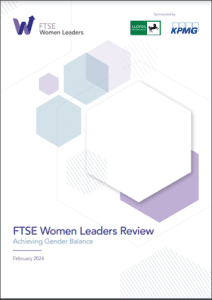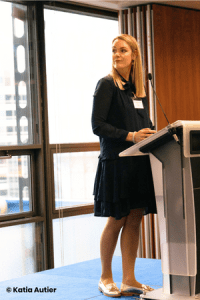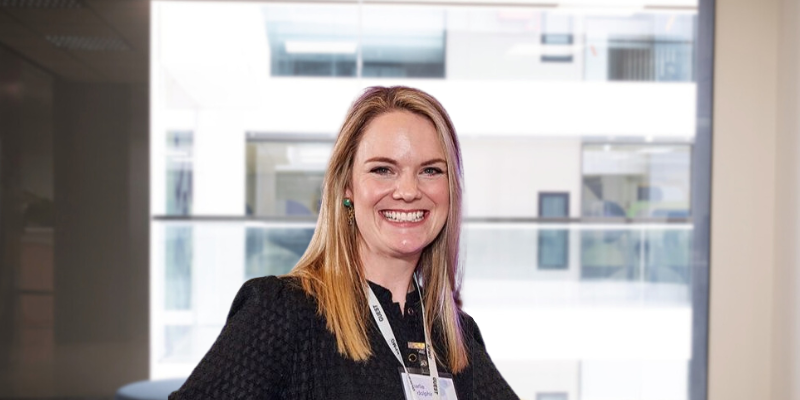Charlie Godolphin is programme lead for the FTSE Women Leaders Review, leading the next phase of an independent, business-led framework that sets recommendations for FTSE 350 and the top 50 UK private companies to improve the representation of women on boards and in leadership positions. Charlie has extensive experience leading large-scale and high-profile programmes, delivering impactful and innovative solutions that drive engagement and cultural change across the UK business landscape. Charlie is currently on a secondment from Lloyds Banking Group, where she is passionate about inclusion and diversity, as well as sustainable business.

“Modern leaders are required not just to steer the ship, but to also serve as societal role models, leading with authenticity, humanity, and vulnerability. This suggests that future CEOs could come from all different areas of business, both men and women.”
About the FTSE Women Leaders Review
I’m going to share our latest findings from our new report, but before I delve into the specifics, let me share an overview of the FTSE Women Leaders Review.
The FTSE Women Leaders Review is backed by the government and sponsored by Lloyds Banking Group and KPMG. We set recommendations to increase the representation of women on the boards and leadership teams of FTSE 350 companies, but also of 50 of the largest top 50 private companies as well.
The review began in 2011 under the Davies Review, and then afterwards the Hampton Alexander Review. Our approach is unique as the review is led by the business for the benefit of business, and it adopts an entirely voluntary approach, avoiding quotas.
It works on a comply or explain basis, and we encourage progress and the sharing of best practice in our annual report. The sheer size and scale of our scope is also unique, we gather data on over 400 companies and both public listed and private, and that’s on over 26,000 board and leadership roles.
For context, virtually no other country monitors roles beneath the board level, and most have adopted a quota-style system. Therefore, the UK outruns its international counterparts in terms of progress, pace, and scale, and all achieved through voluntary efforts. The review is therefore symbolic recognition that the journey to gender balance is not a solidarity endeavour, it’s a collective effort spanning government, businesses, business leaders, headhunters, and many of us attending the Womanthology Inclusion Thought Leaders’ Event.
Driving meaningful change
As the review has evidenced, together we can drive meaningful change, shatter barriers, and set a powerful example for future generations. So, let me start where it all began, with women on boards.
In 2011, women made up just 9.5% of FTSE 350 boards, and there were 152 companies with all male boards. So that was nearly half of all FTSE 350 companies with just men sat around that top table. A report at the time by the Equality and Human Rights Commission said that it would take over 70 years to achieve gender balance on the boards of UK’s biggest businesses.
Let us fast forward to February of last year, when the FTSE Women Leaders Review announced that British business had achieved the 40% women on boards target, three years ahead of the deadline, and we’ve seen even further advances.
FTSE Women Leaders Review 2024 Report findings

Thankfully, the all-male board has become a relic of the past. As of 2019, that 152 figure became zero. In fact, today, almost half of FTSE 350 boards have four or more women on their board. However, the job is not done. There are 29 companies that still have not met the 33% women on boards target that was due at the end of 2020 set by the Hampton Alexander Review. We call upon these companies, who are reputable in other ways, to embrace the business benefits of a gender-diverse board. Not least because investors and customers are watching closely.
The UK as a world-leader for gender balance
This year, the UK has maintained second position in the international rankings for women on boards, behind France and ahead of Norway, cementing our reputation as a world leader for gender balance. It’s evident that the voluntary business-led approach is working well for British business. Equally celebratory is the ambitious scale at which progress has been made. Our approach encompasses some 350 companies, a notable contrast to 40 in France and just 25 in Norway.
Opening up a new career path for senior businesswomen
We have now created a new career path for senior businesswomen that was largely closed and beyond reach for the majority just a few years ago, but the focus now is to ensure that women are not only at the board table but they are also appointed into greater numbers of leadership roles.
The review defines ‘leadership’ as the executive committee and their direct reports, that’s the top two layers of leadership directly below the board and it’s about 80 to 100 roles within a company. Today, women hold over a third of leadership roles in the FTSE 350. We’ve seen an uplift from 25% six years ago, to 35% today.
This is also our second year of reporting on the UK’s top 50 private companies, and our latest report shows that they’re clearly keeping pace with their public listed peers, with 36% women in leadership.
More to be done
Many companies have been working hard for some time, and we are seeing results. Yet, 115 companies are making little or no progress and, in fact, they are yet to meet the previous 33% target that was due at the end of 2020. With only two years remaining to reach the 40% women in leadership target, clearly some companies have got significant work to do. What is also disappointing is the appointment rate for women into leadership roles, is still skewed in favour of men.
In fact, in the FTSE 250 last year, this leapt back to 2019 levels at 36%. So, that means for every ten leadership vacancies in the last year, over six of those were awarded to men. It’s difficult to reconcile, given that there’s no shortage of experienced, talented women who are eager and ready in all sectors of business to take on leadership roles. With just shy of two years remaining until the 40% women in leadership target, we must now see women appointed into almost half of all the available appointments over the next two years if business is to meet its target.
The four key roles
One of our recommendations at the FTSE Women Leaders Review is for FTSE 350 companies to have at least one woman to be appointed in one of the four key roles. That’s the chair, the senior independent director, CEO or finance director. So far, 238 companies have achieved this.
Monitoring progress of women in the four key roles encourages focus at the top of organisations and enables women to progress without limits. These represent some of the UK’s most powerful and influential roles, often shaping employee experiences as well as societal and economic outcomes. Focus here ensures that these roles and the wider UK economy benefit from diverse experiences and perspectives.
In the last year, we have continued to make progress in the four key roles. The representation of women serving as senior independent directors today is at 47%, so nearly gender parity. This marks a significant rise from 16% just six years ago. 15% of chairs and 18% of finance directors are women today. And the FTSE 100 last year saw seven new finance director appointments who were all women, which is an incredibly positive development. However, in the FTSE 250 just one woman was appointed as finance director last year.
More female CEOs needed
In an all too familiar theme, women in the top CEO role remain few and far between at just 8%. New research by Involve suggests that it will take 50 years to reach gender parity, which is undoubtedly the standout, disappointing statistic amongst a sea of progress at every other level. At this stage in the journey, I think we’ll all agree that 8% CEOs being women is somewhat disappointing, to say the least.
It was always going to be the toughest hill to climb. There are only 260 CEO roles in the FTSE 350 because of the number of investment trusts who don’t have that senior chief executive officer role. What’s more, the turnover is low, for obvious reasons with the rewards and the profile that go hand in hand with the role. Is there hope for the future? Well, there are a small but growing number of lead indicators which suggest that faster progress may be on the horizon.
Routes to CEO
If we look at the FTSE 100 today, women make up 30% of executive committees, an all-time high. Research by Russell Reynolds has found that amidst the socio-economic uncertainty we’re currently facing, boards are increasingly turning to their internal backbenches to hire for those top roles. Women in the FTSE 100 also hold one in four finance director roles today, and 27% of chief information officer roles in the FTSE 100.

These are both widely recognised as routes to the CEO position. The business landscape is undergoing unprecedented change with societal shifts, market volatility, and a heightened focus on ESG, the accelerated shift towards AI, and the evolving perspectives of Gen Z. Consequently, the topics that are discussed at the boardroom today are very different to those five, let alone ten years ago.
We recently conducted a survey and it found that just 42% of respondents felt that leaders today possess or are rapidly acquiring the skills needed to navigate these evolving challenges. Today, therefore, CEOs face a challenge to rapidly transform like no other generation before them.
Modern-day leaders
Modern leaders are required not just to steer the ship, but to also serve as societal role models, leading with authenticity, humanity, and vulnerability. This suggests that future CEOs could come from all different areas of business, both men and women. That is why every female appointment into a leadership role deserves to be celebrated and through sustained and increased focus, this will feed into more women in leadership and more CEO appointments.
The clock is ticking
No one doubts that there is more to be done for women in leadership, more to do in the big four roles, especially the CEO, and more to do for all women, of all ages, ethnicities, disabilities, sexualities, and socioeconomic backgrounds. The clock is ticking, and the urgency is clear.
We call upon business to approach gender balance as they would any other business transformation and to double down on their efforts in these final two years. We call upon leaders to be informed, not just to advocate for gender equality, but to have the confidence to step up and take action.
This involves setting clear goals and targets, making public commitments, and reporting on progress focusing on retaining and promoting talented senior women and championing the uptake of flexible working and equal parental leave policies.
Working together alongside male allies
Lastly, we call upon both men and women to work together on this shared challenge. 40% women in leadership is more than a numerical goal. This is about cultivating a culture that drives diversity, where varied perspectives experiences and talents converge to drive innovation and success.
We have made strong foundations on this route map to continue driving progress, and we now have numbers on our side. We’ve revolutionised British boardrooms where women occupied less than 10% of roles over a decade ago to over 40% today. Women on boards marked the beginning of our journey and the area of greatest progress but women in leadership is where it will end, and not until all women across all sectors across all roles are equally represented.
You can download a copy of our latest report from our website and follow us on LinkedIn as well for the latest insights.
Note: The text in this article has been adapted from a presentation at the recent Womanthology Inclusion Thought Leaders’ Event, held at Lloyd’s of London on 28th February 2024.





